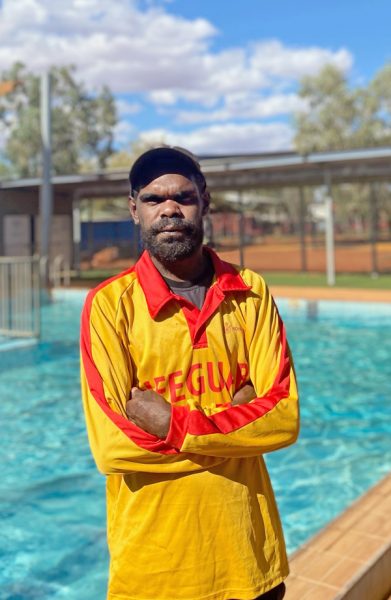Taking the plunge: the Mutitjulu Tjurpinytjaku Centre

We have always taken an evidence base for our community development work seriously. So when the Telethon Kids Institute released research results in 2006 supporting remote Aboriginal community swimming pools, we put some trepidation about the proposed Mutitjulu pool aside.
We knew the pool would be a particularly difficult project because of the large capital cost and the safety and management considerations. And also because Mutitjulu is within the Uluru – Kata Tjuta National Park — a desert, with limited water by definition.
Then run by 2003 Australian of the Year, epidemiologist Professor Fiona Stanley, the Telethon Kids Institute studied the child health benefits of newly built pools in three remote Western Australian communities from 2001 to 2005. Jigalong in the Pilbara, for one, saw ear disease drop 44 per cent and skin disease 51 per cent.
‘We now have firm evidence that these pools are a great investment, not simply for fun, but for a range of health and social benefits,’ Professor Stanley said.
Meanwhile, Mutitjulu kids were swimming in stagnant waterholes at the base of Uluru. Their families recognised the huge health risk especially as the waterholes were topped up with rare rainfall-water which was polluted with the faeces of climbers. They advocated strongly for a pool, and were willing to pay.
Our cost-benefit analysis fell firmly on the benefit side too when Professor Stanley pointed out the strong link between certain skin sores and later heart and kidney diseases and the connection between ear disease, hearing loss and poor education outcomes.
Coinciding with the institute’s research findings, the Mutitjulu working group – locals charged with making decisions about the community’s portion of rent from the national park to the traditional owners – decided to put $100,000 to the pool’s construction. It committed another $1.5m to ongoing pool operations. The Aboriginals Benefit Account contributed three million dollars to the construction and the Mutitjulu Foundation associated with the Ayers Rock Resort, 25 kilometres away, made a substantial grant.
‘The kids are really excited today,’ said working group member Judy Trigger at the pool opening in 2013. ‘This is something we’ve worked hard for.’
The working group had helped us to get national park approval, a suitable construction project manager in the Centre for Appropriate Technology Projects, a company to construct the pool that had built pools in South Australia’s remote Anangu Pitjantjatjara Yankunytjatjara Lands, plus an experienced pool operator.
We’d worked together too on local stakeholder engagement. With a ‘Yes School, Yes Pool’ policy in place; for instance, the Mutitjulu primary school principal reported in 2014 attendance up from 66 to 80 per cent. Elderly and disabled locals and their therapists and mothers with babies have made good use of the pool.
In short, the journey has significantly enhanced the Mutitjulu working group’s capacity to work with large amounts of money, delivering huge health and education potential.
In its first summer, the Mutitjulu Tjurpinytjaku Centre, as the locals named it, averaged 35 visits a day and more than 6,500 visits in total. There have been many more since.
We are glad we took the plunge.


